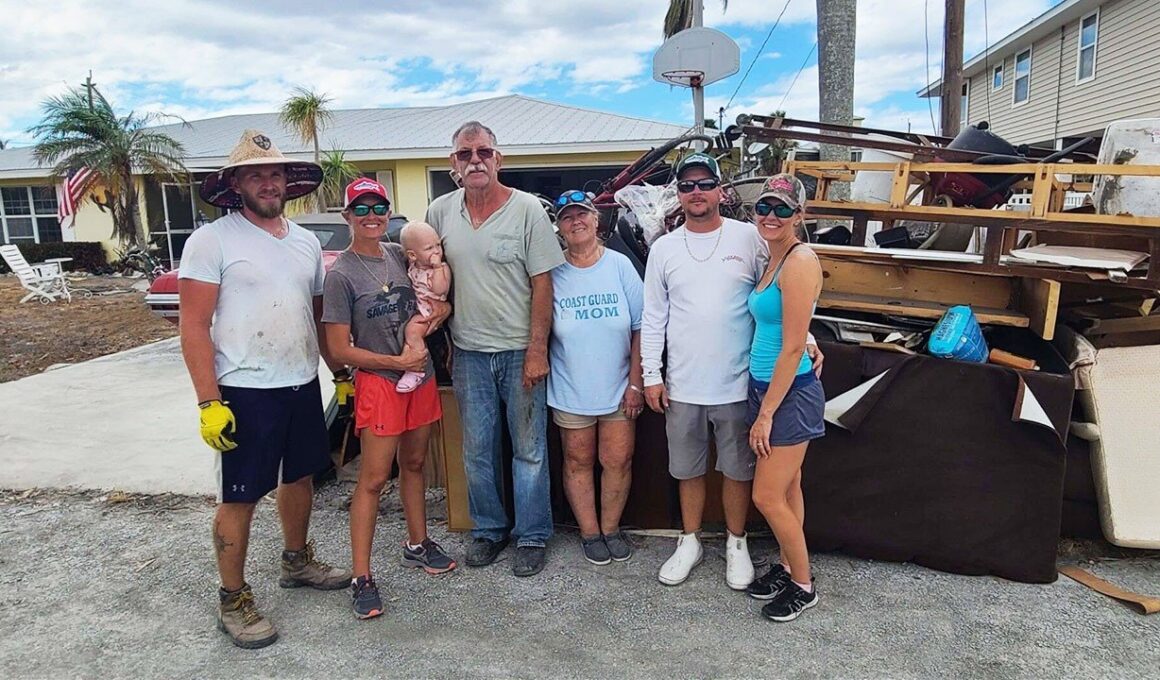This year’s hurricane season is slated to be one of the most active in history, and recent news of a home collapsing in North Carolina due to swells from Hurricane Ernesto has painted a horrifying picture of what these storms can do.
With three months left before hurricane season ends in November, many more storms might be on the horizon, making many wonder: What’s it like to own a home in a hurricane zone—or worse yet, be in the house when a huge storm comes hurtling through?
Kory Covaci has lived through plenty of hurricanes in her 38 years as a Florida native, and her military background helps her feel prepared and calm even in the so-called “eye of the storm.”
But Hurricane Ian in September 2022 was different.
At the time, Covaci and her family were living on Pine Island, FL—one of the barrier islands that was hit hard by this Category 4 storm that became the third-costliest weather disaster in the world on record. Covaci was also a new mother, forced to flee her home with her infant in the middle of the storm to find safer ground.
“Nothing compared to the strength of Hurricane Ian—and the fact that I was now a mother,” says Covaci. “I had an 11-month-old at the time. It was my first child and my first time going through a hurricane where I needed to think about someone other than myself.”

(Kory Covaci)
According to the U.S. Census Bureau, more than 60 million residents live in hurricane-prone zones. And with more moving to these high-risk areas every day, many have no idea what it’s like to live through a hurricane. Here’s a glimpse of what Covaci experienced during Hurricane Ian, and the aftermath.
Before the storm
Covaci and her husband chose to stay on Pine Island through the hurricane with their infant and three dogs. While evacuating is wise for those who can do it, there is a lot to coordinate and it can be financially out of reach for many.
“I’ve been through Hurricane Irma, Charlie, and many others,” Covaci explains. “I did our preparations and knew what we needed to do. Put water in the coolers, check the generator, and put gas in the vehicles. It wasn’t anything new to me.”
She had prepared her home well with hurricane-impact windows, a plug-in generator to power the home, and an extensive hurricane kit. Her parents, sister, and brother-in-law lived near Pine Island’s more vulnerable coastal areas, making Covaci’s house the safest option, so they all gathered at her place while waiting for Hurricane Ian to hit.
When Ian arrived, winds whipped through at 150 mph. The storm surge caused water levels to rise on Pine Island between 7 and 9 feet. It was drastically different from any other hurricane Covaci had experienced.
“The storm started, and we’re in the thick of it,” recalls Covaci. “I’m watching the floodwater rise. I was talking with my husband as I looked out my window at the boat ramp across from my house. I said, ‘If the water crests the road, we are in trouble.’ That happened about 20 minutes later.”
If the water came any higher toward her home, Covaci knew they could not stay put and would have to evacuate to higher ground in the middle of the storm. The reality of the situation hit Covaci when she grabbed the infant life jacket from the hurricane kit and strapped her baby in. Moving to a neighbor’s house, which was built on stilts, was Plan B if the storm surge grew too high.
“Never in a million years did I think I would need to go to Plan B, and I had to go to Plan B,” admits Covaci.
With her family, baby, and pets in crates, they waded through the water, which had risen above their knees. Covaci knew the dangers of moving through stormwater—large, sharp, fast-moving debris was often hiding in strong currents, and could slash or sweep their legs out from under them, toppling them into the water.
Covaci and her family moved slowly and fearfully, and finally reached her neighbor’s home, which was also a haven for the neighbor’s daughter. Once inside, Covaci finally felt relief and tried to relax.
“I knew we were going to be safe because we were in an elevated space,” she says. “But then I transitioned into the worry of what am I coming home to.”
After the storm
Hurricane Ian raged over Pine Island for roughly nine hours, with pelting rain, rising water levels, and intense winds. When the storm ended, Covaci returned to their home and was relieved to see that water had miraculously not penetrated their home. She was lucky. Her extended family weren’t as fortunate.

(Kory Covaci)
“Our first priority was to get to my parents’ house and assess the damage,” says Covaci. “That’s when we realized there was no bridge—it was completely washed away. So we got my brother-in-law’s boat to take the boat down there. My parents came back from seeing their house and were completely defeated and devastated.”
Her parents’ home suffered major losses, including 3 feet of water inside ruining most of their furniture, cabinets, and other belongings.
Covaci’s next priority was to make sure everyone had food. Although the electricity and gas were out, she was able to use her grill and cast-iron skillet to cook hot meals from the provision of fresh produce and meat in the community.
“The cast-iron skillet was amazing because you don’t need soap to clean it,” she recalls. “I put it on the grill with a little bit of water to boil, and it was ready to use again.
“We had about five 5-gallon jugs of water and three different coolers filled with water,” she says. She was nervous about how long that would last.
“Within four days of the storm, we had water back up and going for a two-hour block,” she says. “We scheduled our life around that two-hour window.”
The one thing she wished she had in her kit was a clothespin and clothesline to help dry clothes and other belongings that got damaged or wet during the storm.

(Kory Covaci)
Her parents purchased a camper and parked it on Covaci’s property for three weeks. Once their home was deemed safe to begin renovations, they moved to their own driveway. Since an insurance reimbursement would have taken much longer than they wanted to wait, the Covaci family repaired everything themselves. She got the necessary permits for them, and with the help of friends and family on the island, they rebuilt the interior of the home.
Covaci and her husband also had to repair their home, which became its own ordeal.
“I went through the insurance company, which was a nightmare,” she admits. “I had to go through a verification process with the bank before it could be replaced, so it took a long time. But even then, we didn’t get the full amount I expected because they depreciated the value of the roof based on its life. Luckily, I subsidized it with the grant from the Coast Guard so my roof was completely funded.”
Covaci emphasized how careful you need to be with the out-of-town contractor companies that flock to areas after a storm. While price gouging is illegal, many companies still do it.
Right before Ian, Covaci got quotes to replace her roof with estimates between $15,000 to $17,000.
“After the storm, one of the quotes from a storm repair company was over $50,000,” says Covaci.
As terrifying and tiring as Hurricane Ian was, she says she was glad they stayed on the island. She thought it was the only way to rebuild their lives.
“FEMA is on the ground helping you, but they’re not in your home doing the work,” she explains. “The contractors are so booked out because so many homes are devastated, they might not get out to you for months. It’s largely up to you and your family to rebuild.”
One thing Covaci has learned from this experience is that preparing ahead of time for a hurricane can make all the difference. For those who stay behind, having a plan in place ahead of time is key. If you are in a high-risk flood zone, find a neighbor’s home nearby where they’re happy to let you stay if needed to ride out the storm if water levels get too high.
She is also grateful that she made many renovations ahead of time to protect their home from a hurricane.
“We installed impact windows in 2017, so we didn’t have to worry about boarding up our doors or windows,” she says. She also recalls how grateful she was to have installed an in-house generator plug the year prior. She could run her fridge during the day and air conditioner at night.
“It was $550 to get this installed in 2023,” she says. “After living through Hurricane Ian, I would have paid $5,000, it was that useful.”
Another lesson Covaci has learned that might surprise people is that a hurricane’s strength is not correlated to its damage or risk of flooding. Storm surge can happen anytime and remains the biggest threat during a hurricane.
“What I would change next time is communicating my Plan B better with the family and with any parties involved beforehand,” says Covaci.

(Kory Covaci)








